Crispy Pork Pata: Recipe for a Crisp and Tender Filipino Cut
If there is a great cuisine that needs more attention in America, it’s probably Filipino. The food of the Philippines is simple, yet delicious—especially if you love pork! And one of the great dishes, either for everyday cooking or for big celebrations, is crispy pata. Pata can be prepared in several ways, including slowly braised in soy sauce—which we want to try. But this method of boiling and frying to crisp the skin into a crunchy armor coat of chicharron is going to be hard to beat!
This is a recipe that takes some time—it has a chilling step that you need to account for—but is by no means hard to pull off. With our critical temperatures, you’ll be able to make this dish perfectly your first time. And you’ll be making it often after that! Let’s get to it.
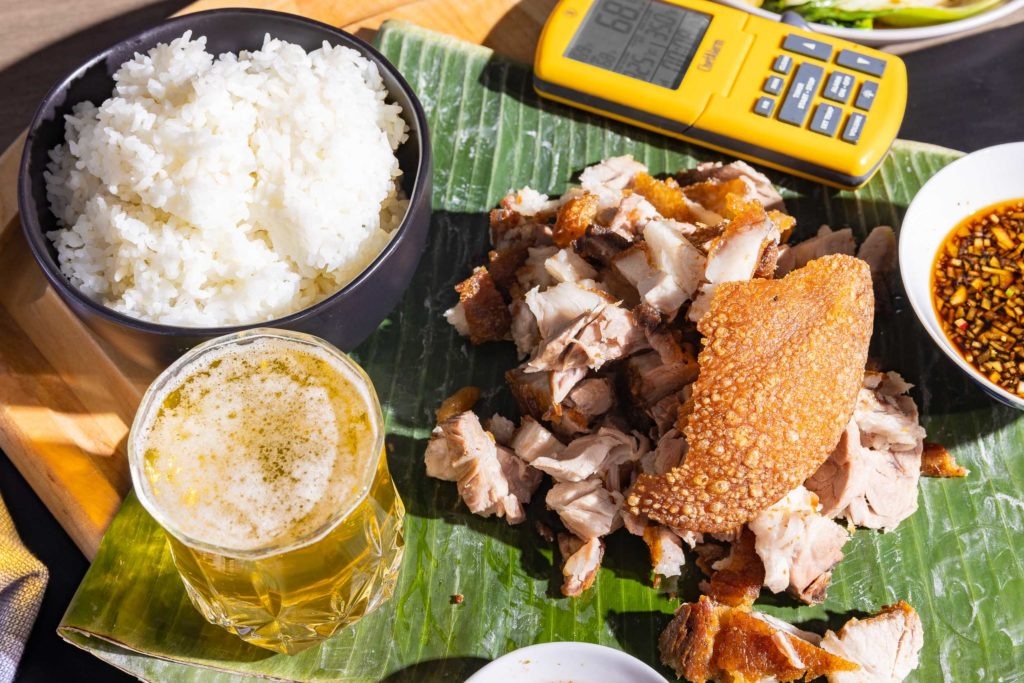
What is pata? What cut should I use?
If you don’t have a Filipino butcher near you (we don’t), you’re not going to be able to walk in and ask for pata. But that doesn’t mean you can’t find it. Pata is the pork leg, the portion from the knee down. That may be hard to come by, but you should be able to find the hock—the part from the knee to the ankle—without much trouble. Most good butchers, especially those at ethnic markets, will have them on hand. We got ours from a local carnicería. The dish is still excellent, and not unauthentic, with just the hock.
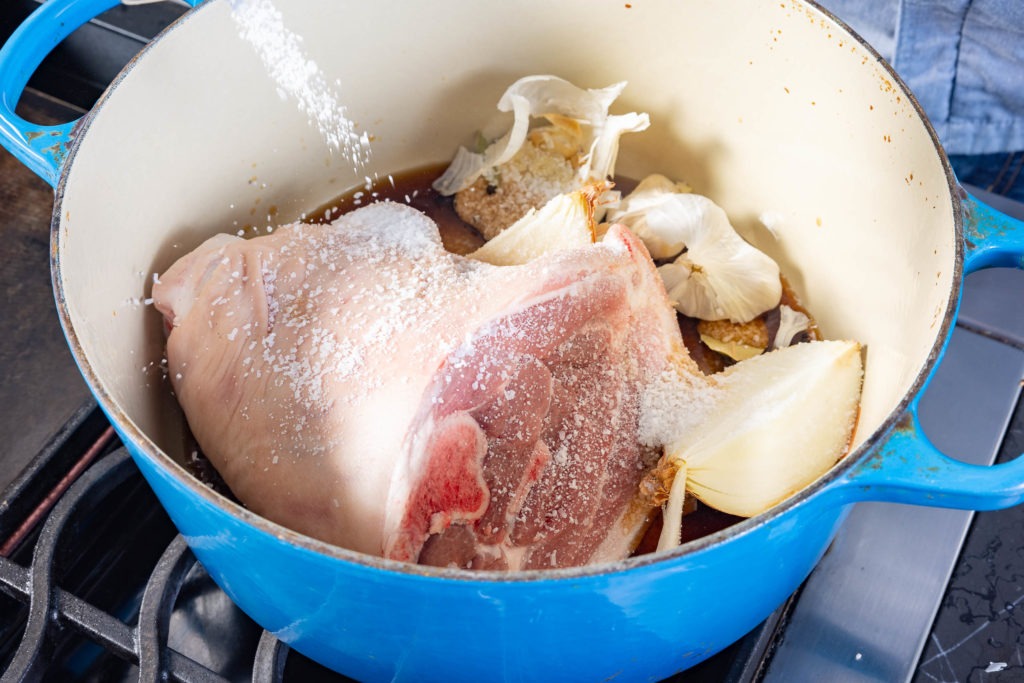
And speaking of authenticity, there are as many ways to make this as there are people making it. Everyone has their own lore about when to rub the meat with what, how long to boil, in what way to fry, and how to season it all along the way. There is no one authentic recipe, and we don’t pretend to be it. But we have looked at a lot of recipes and taken the best bits from each to bring them together for you here. And the results are delicious.
Pork pata thermal challenges
Being the lower leg of the pig, the pata is very well used. And as you probably know, well-used muscles are high in connective tissues, especially collagen. That collagen must be broken down and rendered into gelatin. But beyond the meat itself, we also need to render the connective tissues in the skin of the pork hock so that it can cook up during the frying step to make bubbly, crisp pork rind. For the whole dish to come together, we’ll use the wet, direct heat of boiling to tenderize (and flavor) the meat, then refrigerate it and deep fry it to rewarm it and crisp the skin. Those two steps are where our critical temperatures come into play.
Pork pata boiling time and internal temperature
To make sure that the meat and skin tenderize enough, you need to boil the hock until a good deal of the internal collagen breaks down. Put the meat in the pot with the boiling liquid (more on that liquid later) and bring it to a boil. Reduce the heat and simmer gently until the internal temperature of the hock reaches at least 185°F (85°C). This will take about 60–90 minutes, depending on the size of your pork hock.
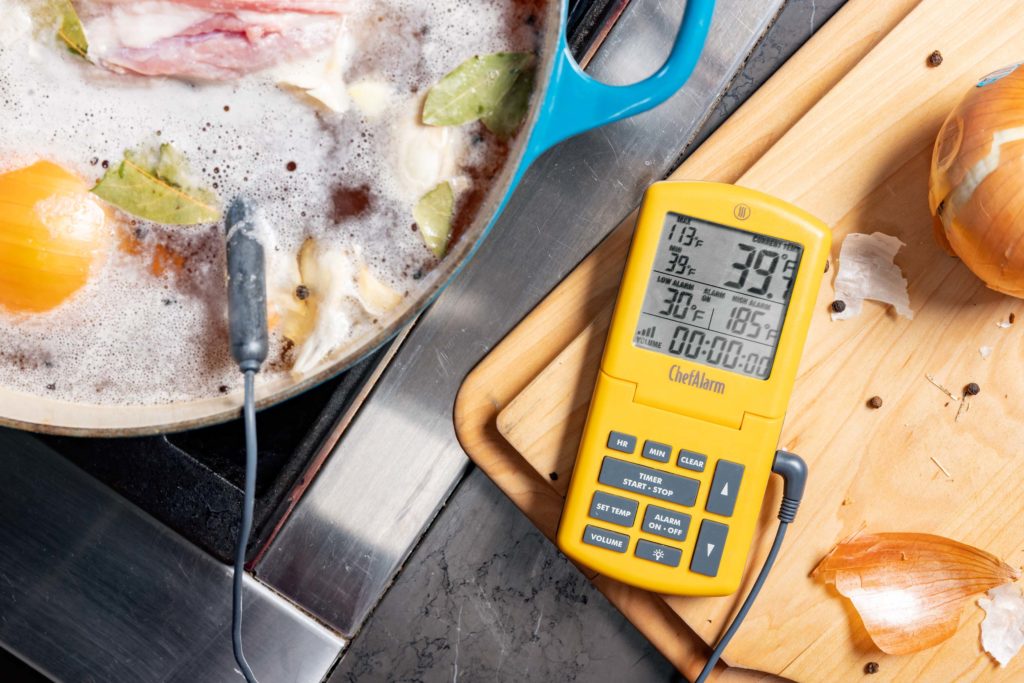
Can we talk about that temperature for a second here? Why that temperature? Well, collagen dissolution doesn’t really get going until about 170°F (77°C). By the time we get to 185°F (85°C) there has been enough collagen/gelatin transformation to make the meat pleasantly tender. This is very much like the temperatures needed in making sliced pork shoulder: it’s tender, but not shredding to the touch. You can cook it further, of course, if you want something even more supple and soft, but as the modus for serving seems to usually be chopping the meat, having it cook until “finger tender” isn’t necessary.
On using thermometers for boiling pata
“But … cooking to temp isn’t authentic.” Ok. That’s not wrong. And if you have a Lola
Deep frying pata: oil temperature
If you want to submerge the pata to fry it and crisp the skin, you’re going to need a big pot and a lot of oil. A better way is to put the pata in a large dutch oven and add oil until it comes just past halfway up the pata. Then remove the pata and start to heat the oil, adding it again once it has come up to temperature—350°F (177°C). Use your ChefAlarm here once again. though this time you won’t need the waterproof needle probe, just the included probe and the pot clip. Set your high-temp alarm for 350°F (177°C) and heat the oil. Adjust the heat as you cook to try to stay as close to that target temperature as you can.
Deep frying is inherently dangerous; let’s just say that up front. This is no different. When you put the pork in the frying oil, any pockets of gelatinized water will heat quickly and expand—explode, in fact. It’s best to add the pork to the pot with the heat turned off, and quickly put a lid most of the way on the pot to avoid catastrophic splatters. Once the initial oil-anger wears off, you can remove the lid.
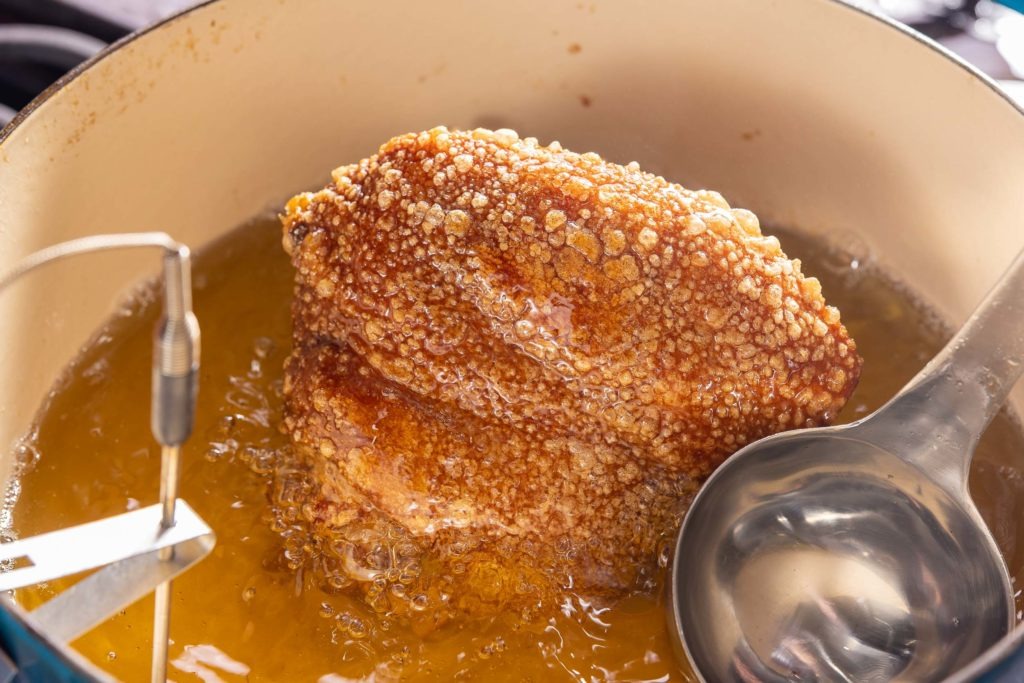
Pork hocks have one side with a lot of skin and one side with just a little. If the lots-of-skin side is facing down in the pot, the weight of the hock will make it hard for the bubbles on the skin to form. So cook it for a few minutes with that side facing down, then turn it over (it will get angry again, just put the lid on until it stops popping) and baste the hock with a ladle, bathing the skin in hot oil over and over. You can flip it back and forth in the pot, turning it so both sides swim in the oil more fully, every few minutes. When the skin is well crisped and the meat is warmed inside (use a Thermapen ONE to check that), after about 15 minutes, remove the pata from the oil and let it drain before pulling the bones out and chopping it up to serve.
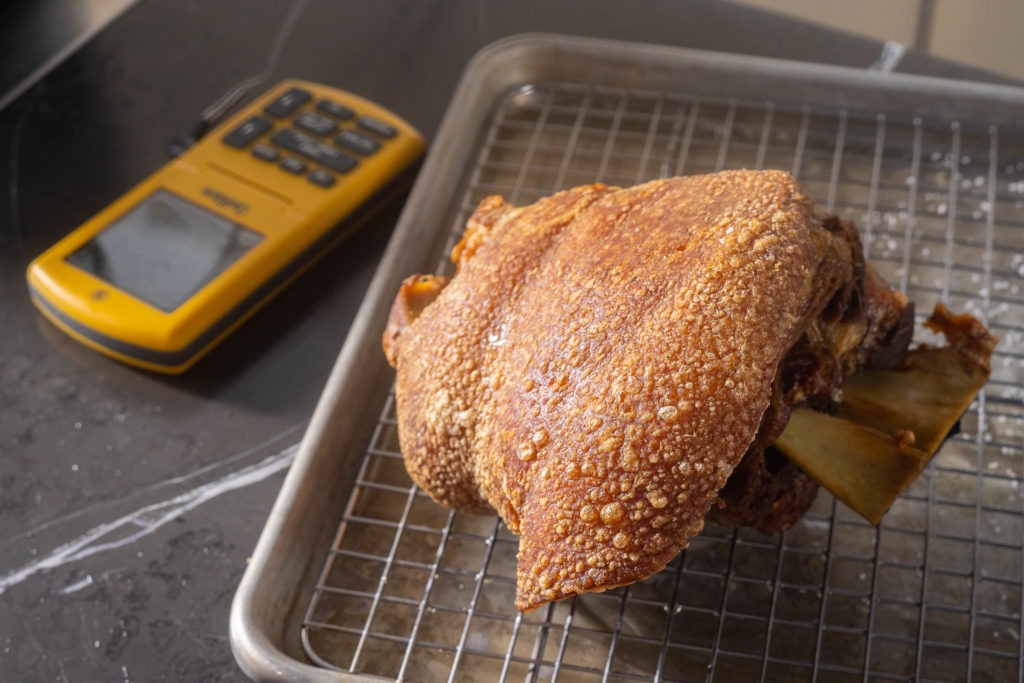
On seasoning crispy pork pata
Pata is a fairly large piece of meat, so seasoning it well can be hard. One of the best things you can do is to boil it in a flavorful liquid. We used vinegar (sugarcane vinegar, if you can get it), bay leaf, salt, black pepper, onion, and garlic—traditional Filipino flavors. While this may not have gotten to the heart of the meat while cooking, it certainly flavored the outside of it well so that it all tasted great when chopped together.
After boiling we rubbed some kosher salt into the skin and put it in the fridge to brine overnight. By adding flavor during the boil and salting it overnight, we ended up with an amazingly flavorful pata on its own.
But we also served it with a traditional vinegar sauce—vinegar, soy sauce, onion, garlic, and chili—that worked wonders when combined with the fatty, rich meat. Don’t skip the sauce!
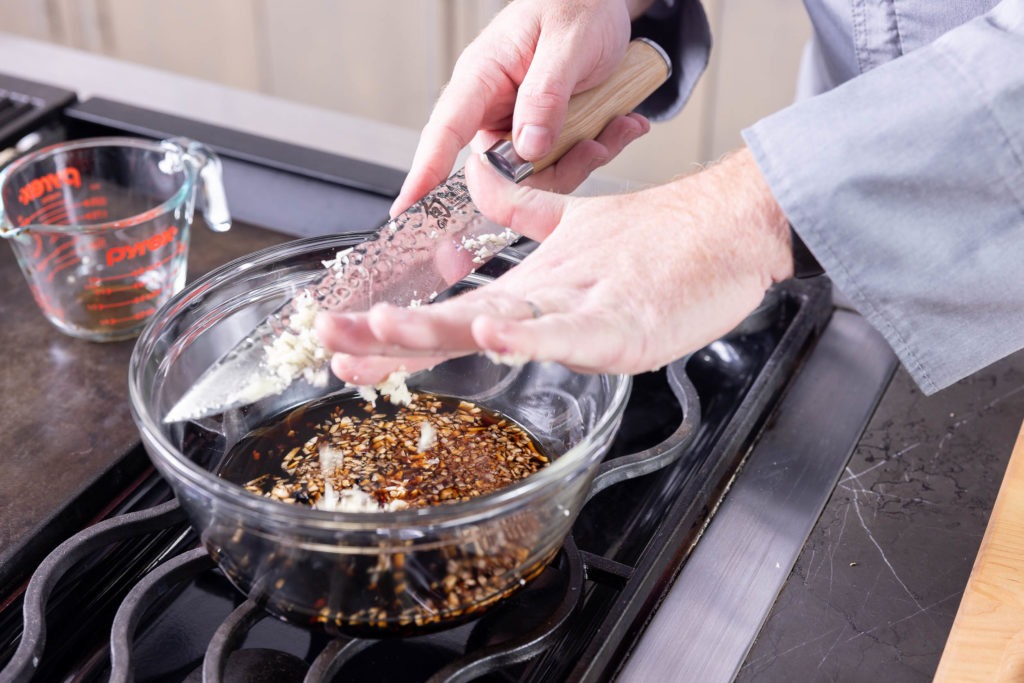
This is one you need to try. It’s not hard, the meat is usually quite cheap, and the payoff is worth easily four times the work. Make it for neighbors, for family, for yourself, for leftovers for sandwiches—it’s amazing for any gathering. Give it a try this weekend, using your thermometer to ensure first-time success. We hope you love it. Happy cooking!
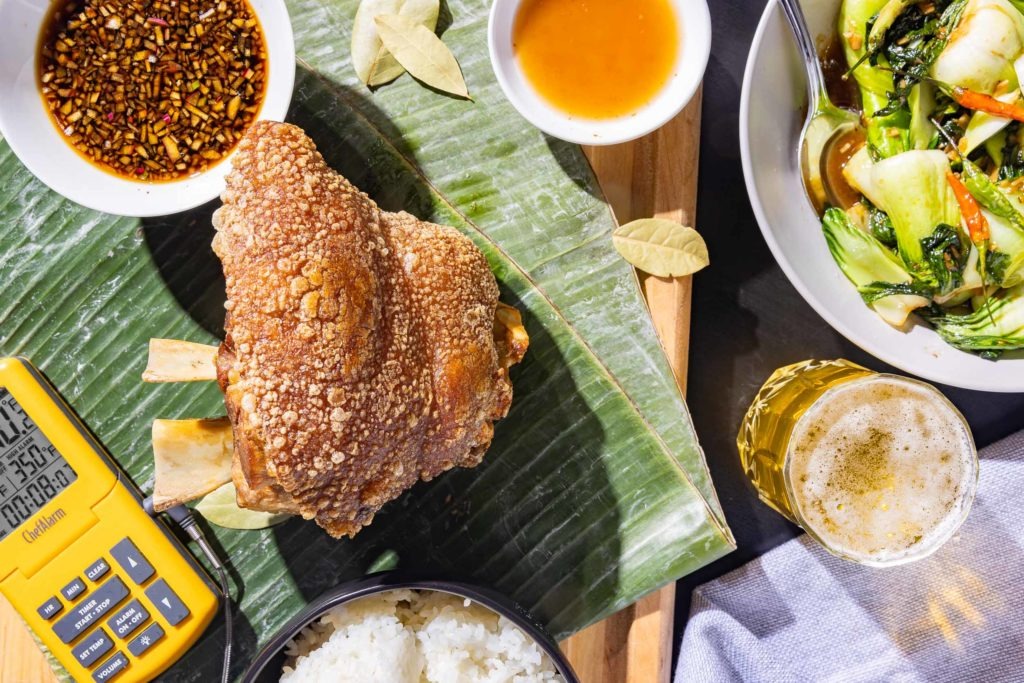
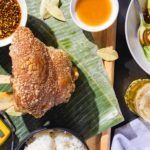
Crispy Pork Pata Recipe
Description
Crispy fried pork pata (pork hock) from the Philippines
Ingredients
- 1 skin-on whole pork hock
- 1 C vinegar (Filipino cane vinegar if available, white vinegar otherwise)
- 1 head garlic, sliced in half across its equator
- 2 tsp peppercorns
- 3 bay leaves
- 1 yellow onion, quartered
- 1/3 C Kosher salt, plus more
- 5–7 C oil
For the sauce:
- 1 C Vinegar (sugarcane if available, or white)
- 1/4 C soy sauce
- 1/4 red onion, minced
- 4 cloves minced garlic
- 3 Thai chilies, minced
- 1 tsp sugar
Instructions
- Put the vinegar, bay leaves, peppercorns, onion, garlic, and 1/3 C kosher salt in the pot.
- Probe the pork hock so that the probe tip is in the thermal center of the pork, not touching the bone. Put the pata in the pot and add water to cover. Set the high-temp alarm on your ChefAlarm to 185°F (85°C).
- Bring the pata to a boil over high heat, skimming any scum from the surface.
- When the water is boiling, reduce the heat to medium-low and simmer, covered, until the internal temperature reaches 185°F (85°C), about 2 hours. If the water level drops, refill it.
- Remove the pata from the liquid and place on a rack set in a baking sheet. Sprinkle with salt all over the skin and press to adhere. Put the pata in the fridge for at least 5 hours or up to overnight. It should be fairly dry to the touch.
Fry the pata
- Place the pata in a pot big enough to deep fry in. Add oil until it reaches halfway up the pata. Remove the pata back to its cooling rack.
- Set up your ChefAlarm with its pot clip to measure the oil temperature. Set the high-temp alarm for 350°F (177°C). Start heating over high heat.
- When the high-temp alarm sounds, add the pata VERY carefully to the oil and immediately put a lid 3/4 of the way on the pot.
- When it stops popping, turn the pata over and replace the lid, allowing the popping to finish again.
- Let the pata cook with its skin side in the oil for about 5 minutes, then turn it with the skin side up and use a heat-proof ladle to constantly bathe the pata in hot oil as it fries. Adjust the heat as necessary during the cook to try to keep the oil at or near 350°F (177°C).
- When the skin is very crisp and the meat is warmed somewhat (test both with your Thermapen ONE), remove the pata to a pan to drain.
- Allow the pata to cool while you make the sauce by combining all the ingredients together and mixing well.
- When the pata has cooled enough to touch, pull the bones out, chop it up, and serve it!
Shop now for products used in this post:


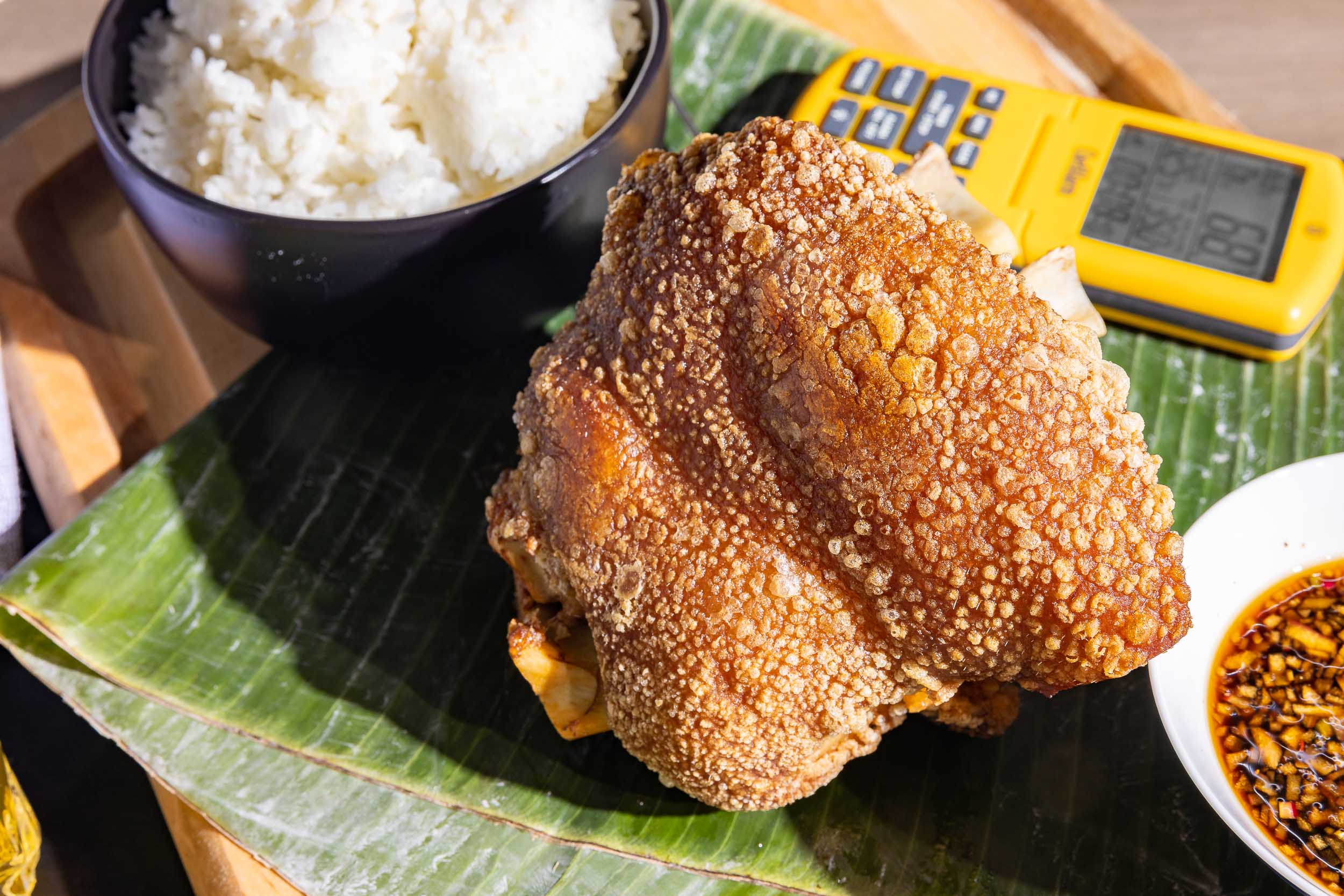
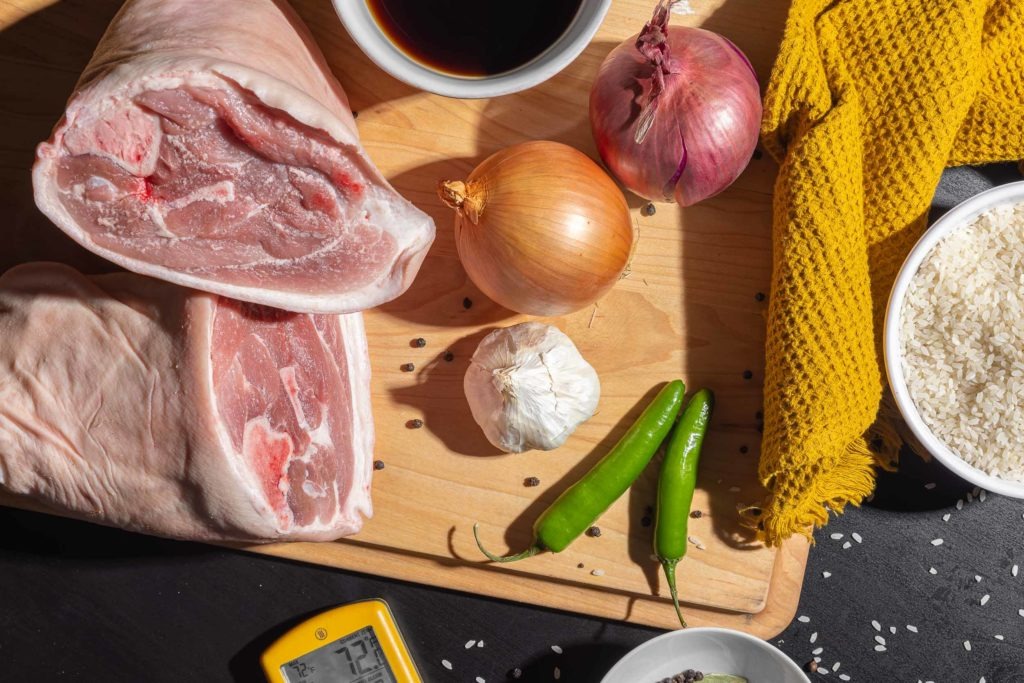
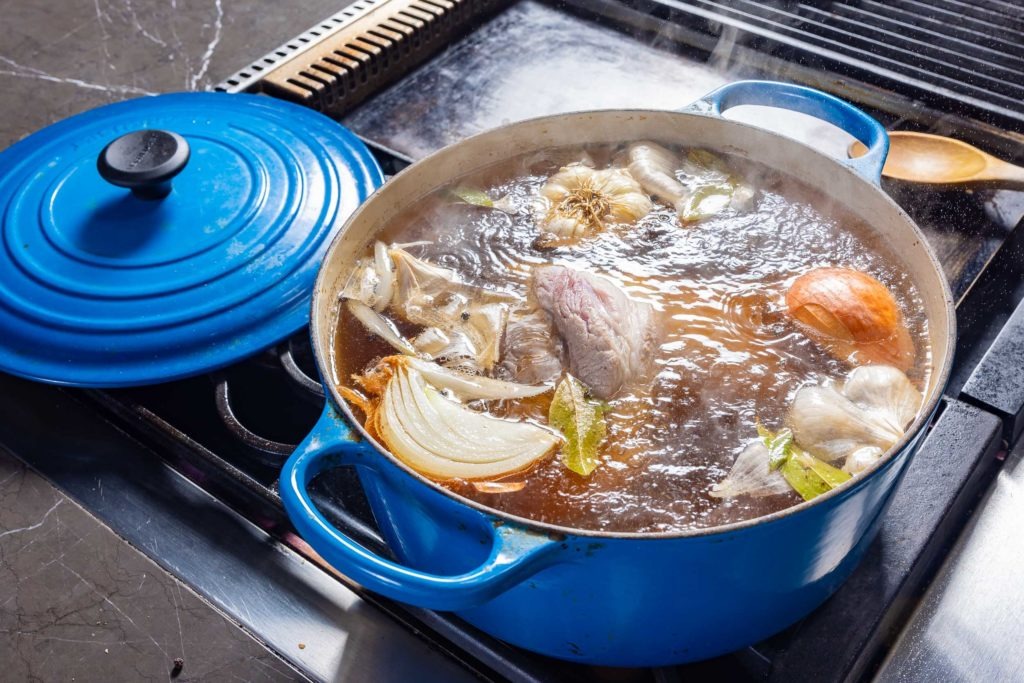
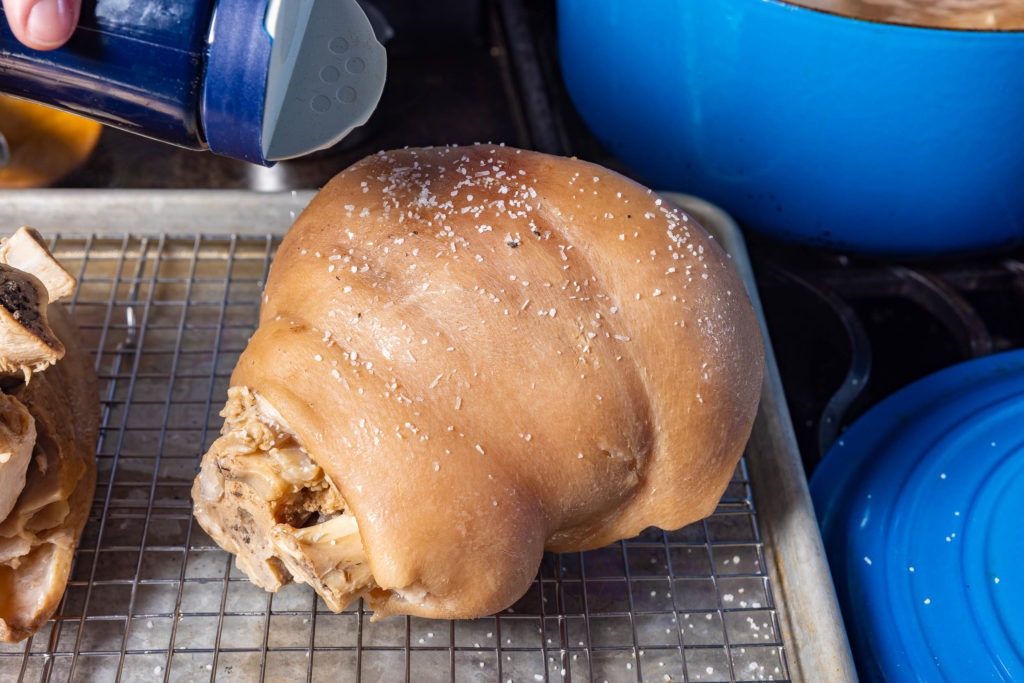
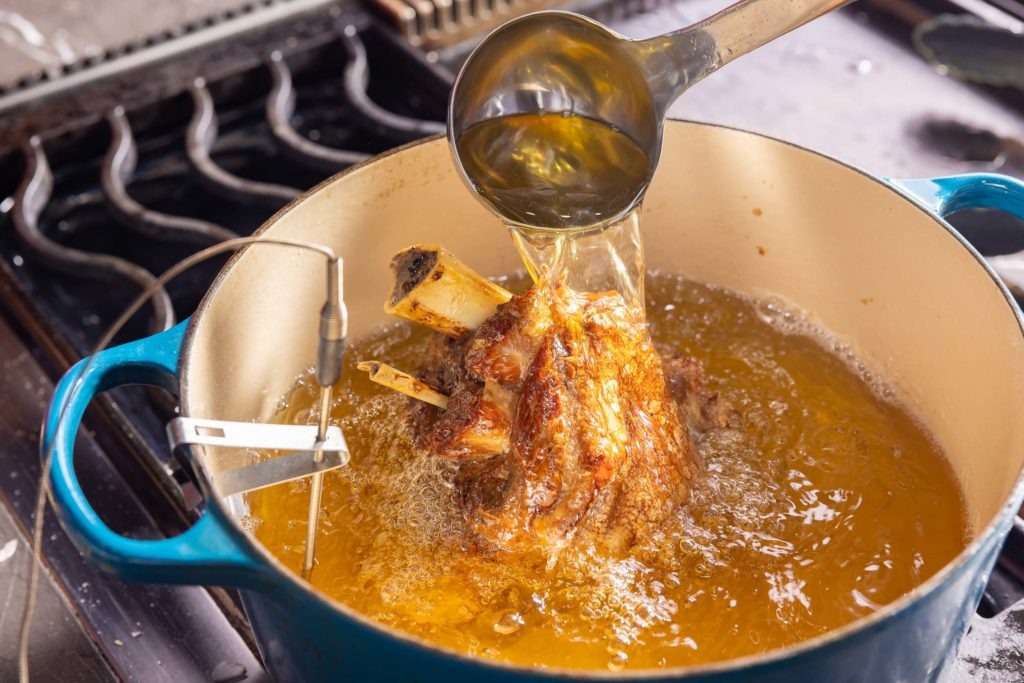

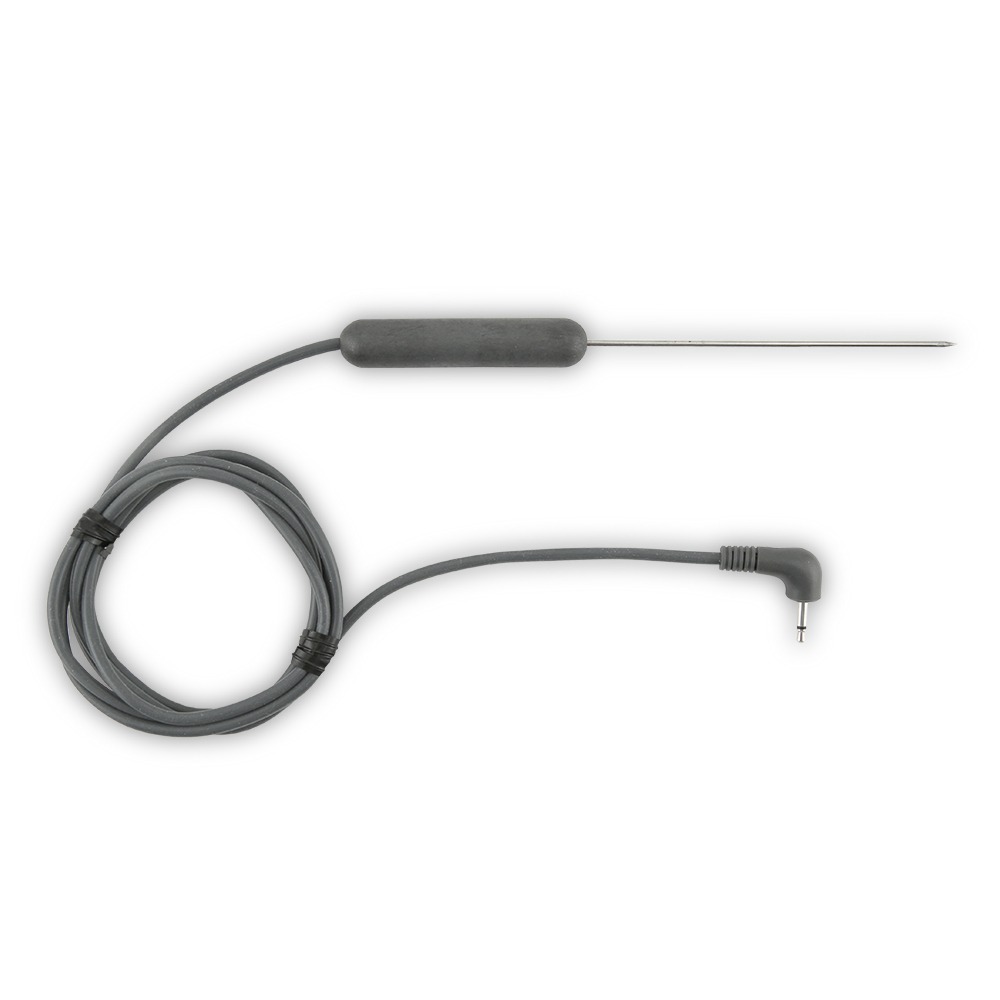

Is there any chance you could crisp that skin up in an air fryer instead of deep fat frying?
Yes, you should be able to! Go 425°F.
Hi Chef Earl.
A question, if I may:
You say the interior of the hock is difficult to season. Would it work to mix up the cooking liquid and inject it into the hock before boiling? Or boiling it first, allowing the liquid to cool, and then injecting it while it dry brines overnight before frying?
Looking forward to your reply.
Pam
An injection before boiling would be your best bet. But with the dipping sauces and the crispy skin, it doesn’t really need it.
Sounds absolutely delicious! Can’t wait to trying this weekend!!!
It is, and I hope you enjoy it!